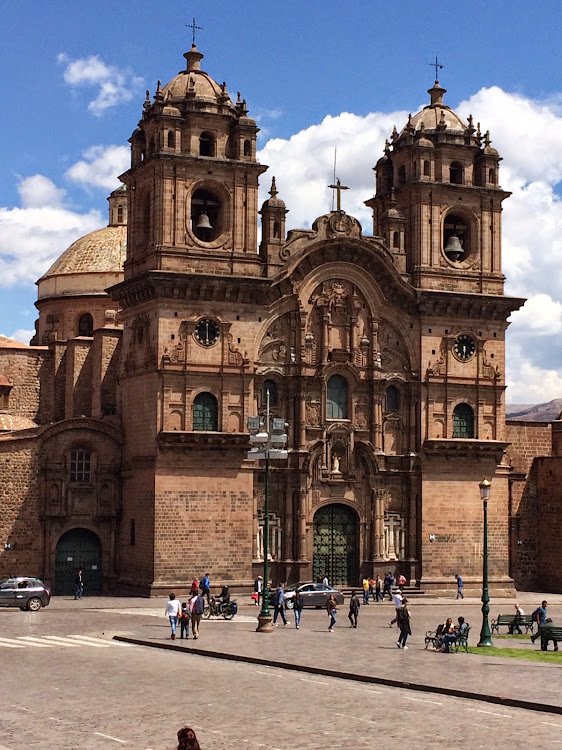Over one afternoon and the next morning, we toured Cuzco and the sacred valley. Our sacred valley tour was private and very informative. The Cuzco tour was a rather cumbersome group. About twenty or twenty five people from different tour groups or travel agents climbed into a bus and saw:
1. The Cuzco cathedral
This was a long tour inside the cathedral (which did not allow photographs, sorry). The tour was kind of...well, sad. The cathedral, like much of Cuzco, was built over Inca sites on Inca foundations, and was used as a training area for Andean artists. The Spanish dominated the Quechua, and their art appears forced and stilted. Pagan symbolism peeks out in different areas of the church as the Inca tried to hang on to bits of their culture.
The Spanish demolished the Kiswarkancha temple and built the cathedral on the site; they also used sacred sands of the temple yard in their mortar and stones taking from the fortress Saqsaywaman in construction.
The hand-carved choir chairs in the cathedral are stunning examples of Inca art. Also notable is the famous Señor de los Temblores, the "black Christ", patron saint of Cuzco. They make him different skirts to wear for different occasions! I was also tickled to see Marcos Zapata's Last Supper in person; Jesus and his disciples drink chicha and eat guinea pig, and the Quechuan Zapata snuck a little jab in at conquerer Francisco Pizarro by giving Judas his face.
 |
| The flag of the Andes (R) outside the Cathedral |
2. Saqsaywaman
An amazing, massive Inca fortress with Cyclopean masonry (basically, gigantic rocks). The enormous stones are fitted together perfectly, without any mortar.
 |
| The stones are even carved to create the corners. |
The design of the fortress is clever; the entrances are all narrow gaps that force an enemy to squeeze in single-file and immediately confront an arrow from a defender from above or behind a corner.
 |
| At the bottom you can see the narrow doorway; also notice the huge stones! |
The fortress walls zig-zag so that anyone climbing the walls would be an easy target for an archer tucked into another corner.
 |
| Atop the fortress walls |
 |
| Doorways in typical Inca shape |
3. Pre-Inca or Inca grave sites
We don't have a lot of information on the grave sites outside of Cuzco, but there appears to be platforms for body preparation along with burial niches in a system of caves. The area was hit by grave robbers before discovery, so it lacks archeological details, but it is thought to be older than the Inca civilization.
 |
| In a burial cave (it was pitch black - that's the flash doing the work!) |
 |
| Our guide by a platform for mummification |
It was hard to take pictures in the dark caves, but outside the grave site was beautiful.
After the tour, we were dropped off at the Plaza des Armas and walked back to our hotel. We stopped for dinner at a little restaurant for alpaca steaks and potatoes and some chicha morada, a sweet drink made of purple corn and spices. Alpaca is surprisingly good and tender, and we both enjoyed it.
 |
| He certainly looks doubtful, but his nearly empty plate tells the truth. He ate that alpaca up. |
Next up: our private tour of the Sacred Valley!












I'm really enjoying my vicarious tour. Not sure about the alpaca steaks though - those animals have the prettiest eyes and I think I'd feel really guilty if I ate one.
ReplyDeleteCyclopean masonry is incredible. I'm always fascinated by stuff like that - those civilisations had to be pretty advanced to work out how to transport and fit those stones.
ReplyDelete